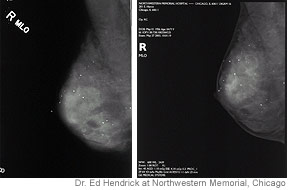Headlines
As reported by The Wall Street Journal, September 17, 2005.
Digital Mammograms Excel In Study
By Kathryn Kranhold

Traditional X-ray mammogram image (left) and digital mammogram image (right) of the same breast.
Digital mammograms are more accurate than traditional film-based X-rays in diagnosing breast cancer in women younger than 50, according to a study that involved more than 40,000 women.
The results, published online by the New England Journal of Medicine, also found that digital technology is better at identifying cancer in women with denser breasts, and those who are pre-menopausal or near menopause.
Those groups tend to overlap, because women under 50 typically have more dense breasts. Digital technology identified 28% more cancerous lesions than film-based technology in the three groups of women, according to the study.
Previous studies have shown screenings with annual mammograms reduce the rate of death from breast cancer in women aged 40 or older. Researchers said the results were significant because of the importance of detecting cancer early in relatively young women -- those under 50 -- and because it is relatively difficult to detect cancer using film in women with dense breasts.
The study, conducted by the American College of Radiology Imaging Network, a medical society, and funded by the National Cancer Institute, didn't find a significant difference in the overall accuracy of digital mammography. But roughly 65% of the 42,760 women screened fell into one of the three subgroups that would be helped, according to the study. (See the NEJM article1.)
Both digital and film-based mammograms involve compressing the breasts between two plastic plates and taking pictures. But digital technology records the images electronically at greater speed, and uses less radiation. Radiologists can then manipulate these digital images on a computer, including the brightness and contrast. This is especially important for women with dense breast tissue because the film images are white, and can mask cancerous lesions.
Dr. Etta Pisano, the lead researcher, said the study was conceived to address "the failings of [traditional] mammograms in dense-breasted women and young women. We now can sit here and say digital does better" in these women, she said.
Dr. Pisano, director of the Biomedical Research Imaging Center at the University of North Carolina in Chapel Hill, said the results don't mean that women under 50 who have had a mammogram using film-based x-rays in the past year need to "rush out to get a digital." For one thing, she said, there aren't enough digital-mammogram machines in service to accommodate all the women who could be helped by the more-accurate screening.
Carolyn Runowicz, a gynecologic oncologist who is president-elect of the American Cancer Society, said the new technology "seems to be more sensitive" to breast cancer in specific groups. The Cancer Society wasn't involved in the study.
Dr. Runowicz, director of the cancer center at University of Connecticut's medical school, said the study does not resolve whether it is cost-effective to use digital mammography, or whether digital mammograms can reduce the death rate from breast cancer. The report could prove a commercially significant breakthrough for the makers of digital-mammography machines. The digital technology has only penetrated about 8% of the market, largely because the machines cost as much as $500,000, or five times as much as film-based machines. Also, insurers don't necessarily pay more for digital exams, even though they cost more.
Digital manufacturers include Fischer Imaging Corp., Hologic Inc., Siemens AG, Fujifilm Medical Systems USA Inc., and General Electric Co.


